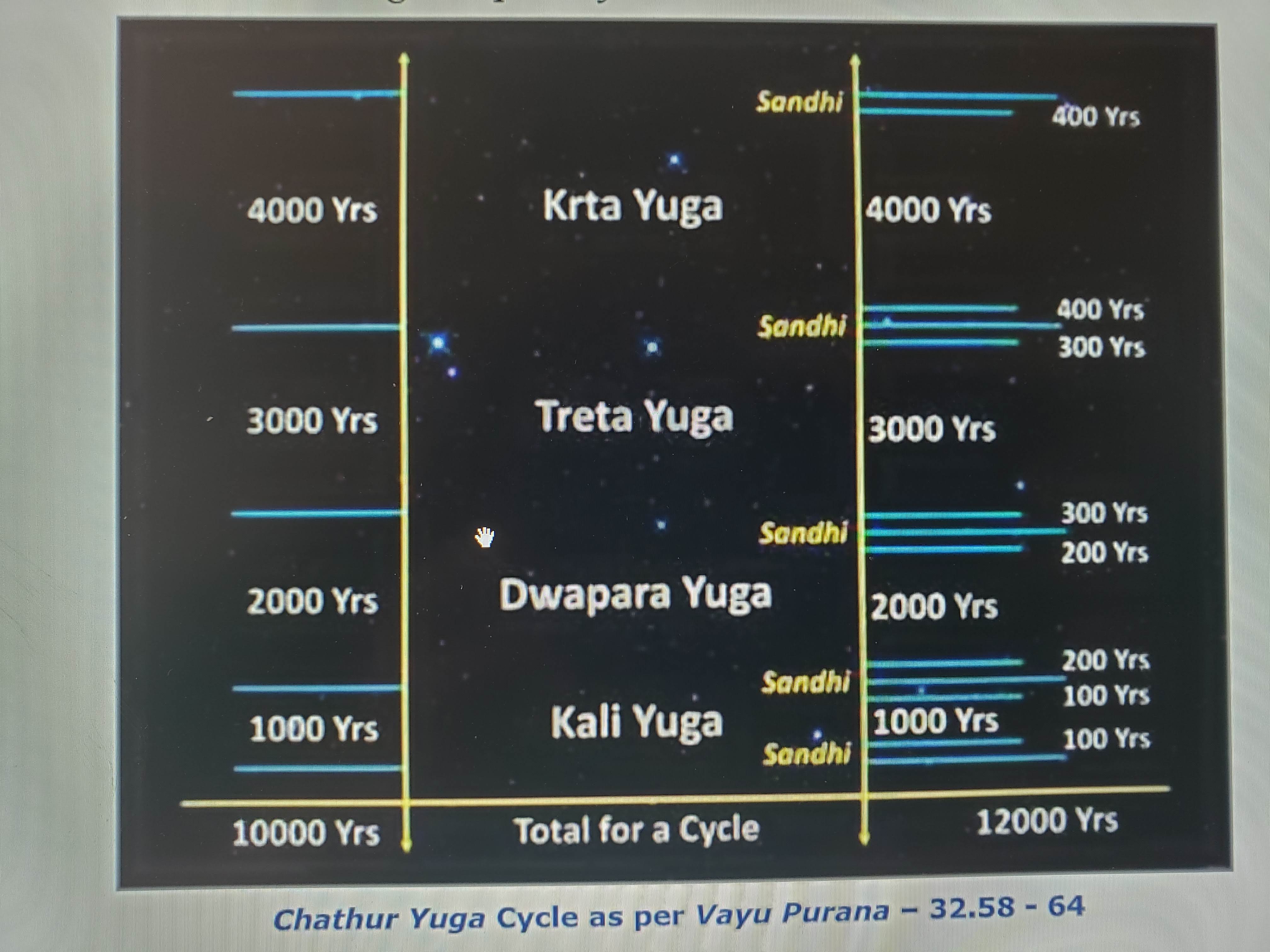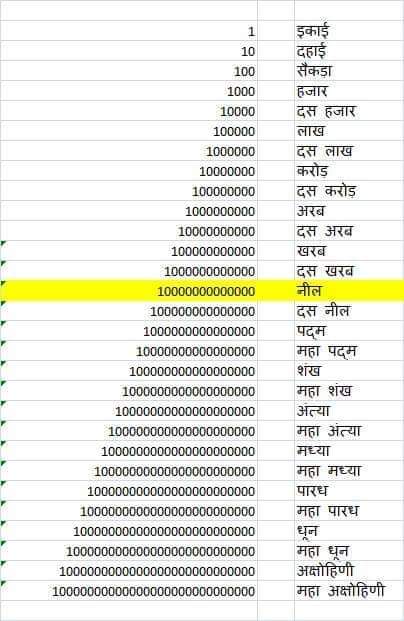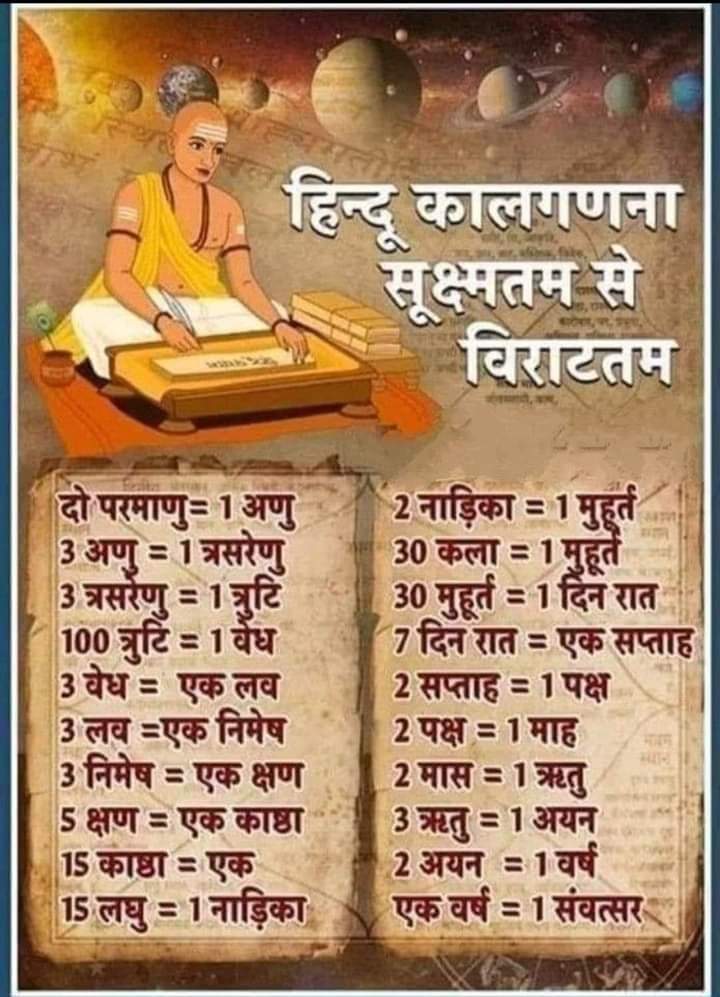- Seven types of Yug are Sanskar ( 4 to 19 earth yrs for education and sanskar ), Manav ( 60 to 120 human yrs i.e. one life of human ), Parivrat(360yrs.),Shasra ( time taken by Sapt Rishis to align with 27 Nakshatrs ), Dhruv ( Three times Shasra ), Aayan(26000yrs, precession cycle), Chathur(4,320,000). One astronomical Yug cycle is 4,320,000 yrs.
- One Yug is 432,000yrs and One Chaturyug is 4,320,000yrs
- Alignment of sun with Mesh rashi, completes a solar year and is celebrated as Uggadi.
- Allignment of Sun, all planets, and Mesh rashi started Kalyug, 3102 BCE. All these were near Meen Nakshatra at that time.
- Every 12 yrs Sun, Earth and Jupiter come in alignment.Jupitor revolves around sun in 12 yrs. Jupirat rotation is of 9hrs, 50 minutes and 24 seconds. Its rovolution is 11.86 yrs and gravity is 4.6. Earth rotation is 23 hrs, 56 minutes, and 0.04 seconds. Its revolution is 365.35 days and gravity is 1. Venus rotation is 243 days, revolution 224.7 days and gravity is 0.8. Mars rotation is 24 hr and 37 min, revolution is 687 days, and gravity is 0.4
- Every 60 yrs. Sun, Earth, Jupitor, and Saturn come in alignment. Saturn revolves around Sun in 60 yrs. Saturn rotation is 10 hrs and 2 minutes, revolution is 29.45 yrs, and gravity is 2.76
- Brahspati Cycle is 60 yrs and each yr has a name. We are in Sarvari or 34th year (in 2020).
- Prabhav
- Vibhav
- Sukl
- Pramod
- Prajapati
- Angiras
- Srimukh
- Bhav
- Yuva
- Dhatu
- Ishwar
- Bahudhanya
- Pramathi
- Vikram
- Vishnu
- Chitrabhanu
- Subhanu
- Dhaarna
- Parthiv
- Avyaya
- Sarvajeet
- Sarvadhari
- Virodhi
- Vikrata
- Khar
- Nandan
- Vijay
- Jay
- Manmath
- Durmukh
- Hevilambi
- Vilambi
- Vikari
- Sarvari
- Plava
- Subhakrt
- Sobhakrt
- Krodhi
- Visvavasu
- Parabhav
- Plavanga
- Kilaka
- Saumya
- Sadharan
- Virodhikruthi
- Paridapi
- Pramathi
- Anand
- Rakshash
- Nal
- Pingala
- Kalayukti
- Siddharth
- Rudra
- Durmati
- Dundubhi
- Rudhrodgari
- Raktaksi
- Krodhan
- Akshya
Yug Cycle

Panch Mandal are
- Surya Mandal
- Prithvi Mandal
- Chandra Mandal
- Para Meshthi Mandal
- Swayambhoo Mandal
Hora is Horalogy or science of time-- Horoscope, Hour
Hindu Time--Yug, Nakshatr, Rashi, Maas, Paksh,Tithi, Vaar,Karan.
Time is curvilinear, not cyclical. It is Kaal chakra.
Earth's rotation on itself causes day and night. Moon's rotation around earth causes repeated waxing and wanning phases. Earth's rotation around Sun causes various seasons.
Day is called Vasar
Month is Maas
Year is Varsh
One day and night is Aahoraatram. Aah is day and Raat is night
One Aahoratram has eight or asth prahars and 30 muhurats
One muhurat has two Ghati
One Ghati has thirty kaala
one Kaala has 30 Kaastha
One Kaastha has 18 Nimeesha
One Nimeesha has 30 Tattpara
One Taatpara has 100 Truti
OneTruti is 29.6 micro seconds
One human year is one Aahoraatrum of Devs
360 such Aahoratts are a year for Devs or Dev Varsh or Dev Vatsara.
4800 Dev Varsh is Satyug or Krit Yug, 1,728,000 human yrs
3600 Devvarsh is one tretayug or Kharv yug, 1,296,000 yrs
2400 Devvarsh is one Dwapar yug, 864,000 yrs
1200 Dev varsh is one Kalyug or Pushy, 432,000 yrs
12,000 Dev varsh are a cycle of 4 Yugs or a ChaturYug(4,320,000 yrs)
71 Chatur Yugs are one Manvantara (306,720,000). There is a different Manu for each Manvantara.
71 Chaturyug plus Sandhyamsha is 308,571,429yrs
1000 Chaturyug or 14 manvantara is one Kalp (4,294,080,000 or 4,320,000,000yrs or 432 crore yrs or life span of Sun)
1 kalp is one day of Brahma or Sristhi.
1 kalp is one night of Brahma or Pralay.
2 kalp is one day and one night of Brahma or one Aahoraatrum of Brahma or 864 crore yrs
Brahmvarsha is one year of Brahma or 360 Brahm Aahoraatris
50 Brahm Varsh is one parardha. 15,552,000 crore yrs
Two Parardha or 100 Brahm Varsh= 31,104,000 crore yrs
Present year 2020 is Brahma's 51st year and is known as Bhavishya Mahakalp.
Mahakalp is one year of Brahma.
Present kalp is Shvet Varah Kalp which is first day of 51st year.
Present Kaliyug is 28th Kalyug ( part of 28th Chaturyug).
3,893,121 years have already gone in 28th Chaturyug.
Month or Maas:
27 star clusters or Nakshatr are in our celestial sphere.
Celestial sphere has 4 Paads and 108 segments and 12 raashis or constellations.
Soorya months are based on nakshatra visible from sun side and Chandra months are based on movement of moon and nakshatra visible from moon side.
Soor maan months Chandramaana months
Based on Rashi Based on Nakshatra
Meen Chaitra
mesh Vaishak
vrishabh Jyeshtha
Mithun Aashad
karkatak Shravan
singh Bhadrapad
kanya Ashvin
Tula Kartik
vrishchik Margshirsh
Dhanur Paush
Makar Magh
Kumbh Phalgun
Aadhik maas occurs approximately every 2.5years
Moon completes its rovolution around earth (29.5 days)quicker than the time taken by Sun to move from one raashi to another (30.4 days) (Sankraman/Sankranti).
Sun is slower in its shift by 0.9 days for every Lunar cycle.
About every 30 months before the Sun can shift into a new raashi, a new cycle of the moon begins.
The Aadhik maas or Purushottam maas can occur in any of the hindu months.
It is also known as Maal month as it gives purification.
Kalbairav is slayer of time. Time destroyes creation.
Kaal Srujati Bhootani, Kaal Sanharati Prajaha, Sarve Kaalasya Vashgaha
Time or kaal creates everything, Kaal destroys everything and everything is in kaals hands.
Chiranjeevi's life is one kalp as everything gets destroyed after one kalp.
Whatsapp forward
समयसूचक AM और PM का उद्गम भारत ही था।
In western world
AM : एंटी मेरिडियन (ante meridian)
PM : पोस्ट मेरिडियन (post meridian)
एंटी यानि पहले, लेकिन किसके?
पोस्ट यानि बाद में, लेकिन किसके?
यह कभी साफ नहीं किया गया, क्योंकि यह चुराये गये शब्द का लघुतम रूप था।
हमारी प्राचीन संस्कृत भाषा ने इस संशय को अपनी आंधियों में उड़ा दिया और अब, सब कुछ साफ-साफ दृष्टिगत है।
कैसे? देखिये...
AM = आरोहनम् मार्तण्डस्य Aarohanam Martandasya
PM = पतनम् मार्तण्डस्य Patanam Martandasya
सूर्य, जो कि हर आकाशीय गणना का मूल है, उसीको गौण कर दिया। अंग्रेजी के ये शब्द संस्कृत के उस 'मतलब' को नहीं इंगित करते जो कि वास्तव में है।
आरोहणम् मार्तण्डस्य Arohanam Martandasaya यानि सूर्य का आरोहण (चढ़ाव)।
पतनम् मार्तण्डस्य Patanam Martandasaya यानि सूर्य का ढलाव।
दिन के बारह बजे के पहले सूर्य चढ़ता रहता है - 'आरोहनम मार्तण्डस्य' (AM)।
बारह के बाद सूर्य का अवसान/ ढलाव होता है - 'पतनम मार्तण्डस्य' (PM)।
■ काष्ठा = सैकन्ड का 34000 वाँ भाग
■ 1 त्रुटि = सैकन्ड का 300 वाँ भाग
■ 2 त्रुटि = 1 लव ,
■ 1 लव = 1 क्षण
■ 30 क्षण = 1 विपल ,
■ 60 विपल = 1 पल
■ 60 पल = 1 घड़ी (24 मिनट ) ,
■ 2.5 घड़ी = 1 होरा (घन्टा )
■3 होरा=1प्रहर व 8 प्रहर 1 दिवस (वार)
■ 24 होरा = 1 दिवस (दिन या वार) ,
■ 7 दिवस = 1 सप्ताह
■ 4 सप्ताह = 1 माह ,
■ 2 माह = 1 ऋतू
■ 6 ऋतू = 1 वर्ष ,
■ 100 वर्ष = 1 शताब्दी
■ 10 शताब्दी = 1 सहस्राब्दी ,
■ 432 सहस्राब्दी = 1 युग
■ 2 युग = 1 द्वापर युग ,
■ 3 युग = 1 त्रैता युग ,
■ 4 युग = सतयुग
■ सतयुग + त्रेतायुग + द्वापरयुग + कलियुग = 1 महायुग
■ 72 महायुग = मनवन्तर ,
■ 1000 महायुग = 1 कल्प
■ 1 नित्य प्रलय = 1 महायुग (धरती पर जीवन अन्त और फिर आरम्भ )
■ 1 नैमितिका प्रलय = 1 कल्प ।(देवों का अन्त और जन्म )
■ महालय = 730 कल्प ।(ब्राह्मा का अन्त और जन्म )
As per Indian Panchang system, each year has a specific name and that each name has a meaning. There are 60 names of years (Samvatsars). Each name replays after 60 years. The year typically begins in mid-April.
The year 2019-20 was named ‘Vikari’, that lived up to its name by being a ‘illness’ year!
The year 2020-21 was named ‘Sharvari’, meaning darkness, and it did push the world into a dark phase.
Now the ‘Plava’ year (2021-22) is beginning. ‘Plava’ means, "that-which ferries us across". The Varaha Samhita says: this will ferry the world across unbearable difficulties and reach us to a state of glory. And take us from darkness to light. Plava means one which floats , practically we will be floating through the year as we will see lot of unrest, shortage of food, bloodshed. Hari nama smarna is the only way out .
The year 2022-23 is named ‘Shubhkrut’, meaning that which creates auspiciousness.

Panchang is an ancient method of timekeeping. It has 5 main components: Tithi, Yoga, Karana, Nakshatra, and Vaar. Other than being a calendar, it is used in astronomy, astrology, and locating the positions of planets and stars.

Documentary: Explained Time on Netflix
Bharti Raizada
When earth revolves round the sun, four coordinates are formed. 1. Winter solstice known as uttrayana, summer solstice known as Daksinayana, Vernal equinox known as Devayana and Autumn equinox known as Pitriyana. The year can be started from any of these four coordinates depending upon the location of your country on the earth. That is why we find in ancient India years starting sometimes from Autumn equinox, Uttarayana, Daksinayana and now Vernal equinox. The Madhu Madhava months mentioned in the Yajurveda 13/25 just tell about the months of six Ritus. This mantras never tells that Madhu, Madava forms the vasant Ritu. It never says that Madhu month is the starting point of year. Madhu is mentioned the starting point of Vasant Ritu, in case of six ritus. On the earth different regions experience different seasons. In india there are six seasons of two months each, in North America, there are only four seasons of three months each. In India vasant Ritu starts fronm 18th Feb. but in North America it starts from 21 March. On poles, there are only two seasons of six months each: summer and winter. Summer season starts with summer solstice and winter starts with winter solstice and vice-versa. When it is summer on north pole, it is winter on south pole. In case of six seasons also, when it is vasant in the northern hemisphere, it is Sarad Ritu in the southern hemisphere and vice versa. Vedic seers know this fact, Vedic knowledge is universal it does not belong to one single region of country. So Veda never says that the Vasant is the starting point of year. Year can be started with any of the four coordinates only.
शरद्वसन्तयोर्मध्ये तद्भानु: प्रति पद्यते। मेषादौ च तुलादौ मैत्रेय विषुवत्स्थित:। The above sloka quoted in the name of Vyasa belongs to some Purana, The author of Purana has stated that 21 March is the middle point of Vasant, that is true only in case of Bharat and not in case of other countries where there are two or four seasons. Vedic seers were also aware of it, that is why many Vedic texts quotes two, three, four, five or six seasons in view of the prevalence of different seasons on different parts of the earth. This mantras cannot taken as proof, being lopsided. Only Vedic references can be taken as proof being universal. Universal vision is called Arsha vision.
Months or Masa are so called because they are formed of Chandrama. Here it may be known that in the formation of months, earth's rotation or revolution are not the cause, but Moon's revolution round the earth is the cause. That is why with reference to one of the Rigvedic mantra अरूणो मासकृद् वृकः, Yaska, an ancient Vedic Scholar says : अरूणः आरोचनो मासकृनमासानां चार्द्धमासानां च कर्ता भवति चन्द्रमाः वृकः. That is moon is the maker of half months and months. In fact, the word 'masa' is formed of the -masa of Chandramas. Regarding Moon, one of the Vedic Mantra says: nakashtranam upasthe soma ahitah. that Moon is sitting in the lap of Nakshtras. So, lunar months are named with respect of Moons position on the day of that months Purnima. The name Mesha is called first Rashi. No doubt these mesha etc. name of rashis are not Vedic. Vedas just mention 12 rashis. But the later Vedic people who gave these names they start the rashis with Mesha as first. On Purnima When sun is in Mesha Rashis or Ashwini Nakshtra the moon will be 180 degree opposite rashi or nakshtra, ie. in chitra nakshtra, so when the sun is in mesha rashi, the month will be called Chaitra. In addition, the chandra months are reckoned from Amavasya to Amavasya or Purnima to Purnima. These months are called synodic months. Similarly when moon revolves round the earth with respect to a particular nakshtra and it comes to the same nakshtra after completing its orbit, that chandra month is called sideareal month. So both synodic and sideareal months are based upon Moon. Sun is not required for their existence. Moreover, a glaring thing I came across in the Vedas, that the Vedas at many places prefer to use sidereal lunar months, because human menstrual cycle is synchronised with lunar cycle.
There are two methods of naming months on the basis of nakshtras. Firstly months are named as per solar sankranti intervening two amāvasyas. For example, when two amāvasyās are intervened by Meṣa Saṅkrānti, intervening Pūrṇimā will be called Chaitra Pūrṇimā and the month will be named accordingly. Below is given the list how the intervening Pūrṇimās are named as per various intervening solar saṅkrāntis and accordingly the months are designated.
Intervening Saṅkrānti Intervening Pūrṇimā to be named
मेष चैत्र
वृषभ वैशाख
मिथुन ज्येष्ठ
कर्क अषाढ
सिंह श्रावण
कन्या भाद्रपद
तुला आष्विन
वृश्चिक कार्तिक
धनु मार्गशीर्ष
मकर पौष
कुम्भ माघ
मीन फाल्गुन
Accordingly, if two amavasyas are intervened by two solar saṅkrantis, then the month to be named after the first solar saṅkrānti will be expunged and called as kṣaya month. On the other hand, when there is no Sankranti between two Amāvasyā-s, the previous month repeats itself. This repeated month is called intercalated month of Adhika month. In ancient period this method of naming months was used.
Another method of for naming the Months is given by Sūrya Siddhānta which is given as under
कार्तिक्यादिषु संयोगे कृत्तिकादि द्वयन्द्वयम्।
अन्त्योपान्त्यौ पंचमश्च त्रिधामासत्रयं स्मृतम्॥ सूर्यसिद्धान्त 14.16
If the moon near Purnima is located in particular Nakshtra the months are given particular names. For example:
मास का नामकरण पूर्णिमान्त चन्द्रमा का नक्षत्र
(Name of the Month) Location of Moon near the Pūrṇimā
1 कार्त्तिक कृत्तिका, रोहिणी
2 मार्गशीर्ष मृगशिरा, आर्द्रा
3 पौषः पुनर्वसु, पुष्य
4 माघ आश्लेषा, मघा
5 फाल्गुन पूर्वफल्गुनि, उत्तरफल्गुनि, हस्त
6 चैत्र चित्रा, स्वाती
7 वैशाख विशाखा, अनुराधा
8 ज्यैष्ठ ज्येष्ठ, मूल
9 आषाढ पूर्वाषाढा, उत्तराषाढा
10 श्रावण श्रवण, धनिष्ठा
11 भाद्रपद शतभिषक्, पूर्वभाद्रपद, उत्तरभाद्रपद
12 आश्विन रेवती, अश्विनी, भरणी Presently this method is followed
So far as the solar nakshtra months are concerned, the month of solar mesha sayana sankranti will be called as Chaitra. Which will start from 21st March and not from 18th Feb. Let me also clarify one more thing that before the introduction of Chaitra, Vaishakha etc. month in India, these madhu, madhava etc. months were also used as Chandra month. We find Taittiriya Samhita using them as Chandra months. So when these months will be taken as Chandra, madhu will replace the modern lunar Chaitra month and not the solar chaitra month.
6 to 9 pm is Called Rudra
9 to 12 midnight is called Rakshasha
12 midnight to 3 am is Gandharva muhurat
3 to 6 am is Brahm mahurat or Amrit vela